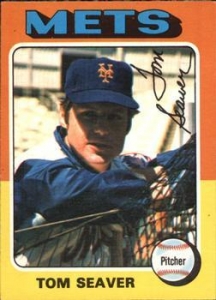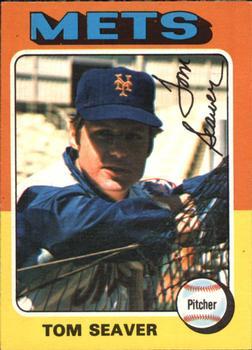April 17, 1977: Tom Seaver throws his fifth one-hitter to lead Mets past Cubs
 The New York Mets were 4-4 nine days into the 1977 season. All of those wins had come from two of their starters, Tom Seaver and Nino Espinosa. The Chicago Cubs had arrived in town two days earlier, beating the Mets in the first game of their three-game series at Shea Stadium on April 15. Espinosa pitched a complete game the next day to lead the Mets to a 4-1 win.
The New York Mets were 4-4 nine days into the 1977 season. All of those wins had come from two of their starters, Tom Seaver and Nino Espinosa. The Chicago Cubs had arrived in town two days earlier, beating the Mets in the first game of their three-game series at Shea Stadium on April 15. Espinosa pitched a complete game the next day to lead the Mets to a 4-1 win.
A crowd of 35,337 showed up on the chilly Sunday afternoon of April 17, as 17-mph winds blew through Flushing. The fans had come for Photo Album Day, as well as a chance to see Seaver take the mound for the final game of the series. There was an additional chill surrounding the Mets: Seaver and Mets President M. Donald Grant were at odds over a new contract for the team’s star pitcher.1
Despite his differences with the front office, Seaver had started off the season in top form. He won their Opening Day game, pitching seven innings and striking out seven in a 5-3 win over Chicago. He was even better in the home opener on April 12, shutting out St. Louis on five hits and lowering his ERA to 1.69.
Seaver breezed through the first inning, getting the Cubs out in order. He issued two-out walks in each of the next two innings, but George Mitterwald ended the second by hitting into a force out and Iván de Jesús was caught stealing to close out the third.
Bill Bonham started for the Cubs. The right-hander was looking to get his career on track after three consecutive losing seasons, including a league-worst 22 losses in 1974. Bonham had won his first outing of 1977, a complete-game 6-2 win over the Philadelphia Phillies.
The Mets jumped on Bonham in the first. Lee Mazzilli, with more than 60 family and friends from Brooklyn and New Jersey on hand, led off with a single. Bruce Boisclair’s double to right-center brought home the 22-year-old Mazzilli, who was on an Opening Day roster for the first time after debuting with the Mets in September 1976. It turned out to be the only run Seaver needed.
After an uneventful second, the Mets scored off Bonham again in the third. Mazzilli led off with a drag-bunt single. Felix Millan’s grounder got Mazzilli to second. Bonham struck out Boisclair, but Dave Kingman, who had also expressed unhappiness over his contract, hit a two-run homer that sailed over the 371-foot mark in center field.2 It was his third home run of the season, all of them against the Cubs.
Seaver cruised through the first four innings. His no-hitter was preserved in the fourth when Ed Kranepool made the final out on Bobby Murcer’s fly ball. Jack Lang of the New York Daily News wrote, “Steady Eddie drifted uncertainly back to the plexiglass wall in front of the bullpen. For a first baseman, he made a helluva catch on a ball that was swirling around in the stiff breeze.”34
Kranepool had his second chance to help Seaver maintain the no-hitter one inning later but failed to come through. With one out, Seaver threw Steve Ontiveros a changeup down and away.5 Ontiveros reached out and got a piece of it, hitting a looper to right field.
Kranepool dived for the sinking liner, but the ball landed inches in front of the right fielder. Umpire Gerry Crawford was there to make sure that Kranepool only trapped the ball and didn’t catch it. “I knew he had a no-hitter going so I figured why not try for it,” said Kranepool. “I didn’t want to give up on it, so I dove and even then I just missed it by a couple of inches and short-hopped it.”6
Seaver said later that he was not disappointed with Kranepool for failing to catch the ball. “I didn’t say a word to Ed about the hit and he didn’t say anything to me about it. I just asked him about his knee. (Kranepool injured his knee in the attempt and was replaced in the seventh by Mike Vail.) I thought Ed gave it an excellent try.”7
Seaver retired Mitterwald and Manny Trillo to strand Ontiveros on first. He retired the Cubs in order in the sixth and seventh, preserving the 3-0 advantage.
The Mets added to their lead in the seventh thanks to poor defense by the Cubs, as three runners crossed the plate on four errors and just one hit. Jim Todd, who had taken over from Bonham in the sixth, was on the mound. The Mets’ Roy Staiger led off with a groundball to third. Ontiveros had an easy play but juggled the ball and then threw it low. By the time the ball arrived at first, Staiger was safe.
Then Bud Harrelson hit a bouncer toward first that found a way through Larry Biittner’s legs, putting Mets at first and third. One out later, Mazzilli hit another bouncer toward first. Biittner caught the ball this time, but his throw home went wide. Staiger scored on the Cubs’ third error of the inning.
Millan followed with another groundball to Biittner, whose throw to second for the force out was dropped by de Jesús. Boisclair singled to score two runs, giving the Mets a 6-0 lead.
“In that inning they looked like the New York Mets of 1962-1965 inclusive,” said Seaver. “I felt bad about Todd as he stood out there and saw them fumbling away double-play balls.”8
Chicago manager Herman Franks said of the bad inning, “That didn’t decide the game. You don’t get any hits, you don’t get any runs. What can you do?9
Seaver walked two batters in the eighth, giving him four for the game, but a double play snuffed out any hopes the Cubs might have of scoring a run. He closed out his third win of the season on three groundouts in the ninth. It was the 41st shutout of Seaver’s career.
Murcer, who saw his seven-game hitting streak end, said of Seaver, “[He] uses everything. Late in the game, when his fastball wasn’t so alive and there were shadows between the mound and the plate, he went more with his breaking stuff. In the shadows, it was harder to follow. He thinks of everything.”10
Seaver was asked if he regretted missing the no-hitter, the fifth time in his career that he had come up one hit short. “Yes, I’d like to pitch a no-hitter before I’m through.” He went on to explain his perspective on coming up short, saying, “It’s like the time that I missed a hole-in-one in golf. I missed it by three strokes. See, if you miss the ideal you’ve missed it. It doesn’t matter how close you come.”11
“I’m ecstatic the way the season is going for me,” Seaver added. “I wasn’t happy with my pitching until today. Now I couldn’t be happier. My control was good. I had a good live fastball, a good slider, and my curve was breaking where I wanted it to. And [my Mets teammates] are getting me runs. Five, four, and six in three games. A pitcher wants consistent offense behind him as well.”12
Seaver continued to pitch well, running up a 7-3 record with three shutouts and 72 strikeouts through mid-June. But his relationship with the Mets continued to deteriorate. More and more rumors circulated that the Mets were looking to trade him, as negative coverage from Dick Young of the New York Daily News fanned the flames.13
The rumors became reality on June 15, when the Mets dealt Seaver to the Cincinnati Reds at the trading deadline.14 His 11-season tenure in New York, yielding 189 wins, three Cy Young Awards, and the 1969 World Series championship, was over.15 It was as a Red that Seaver, after so many near-misses, finally pitched a no-hitter, mastering the St. Louis Cardinals on June 16, 1978.
Acknowledgments
This article was fact-checked by Bruce Slutsky and copyedited by Len Levin.
Sources
In addition to the sources cited in the Notes, the author used the Baseball-Reference.com and Retrosheet.org websites for box score, player, team, and season pages, pitching and batting logs, and other pertinent material.
https://www.baseball-reference.com/boxes/NYN/NYN197704170.shtml
https://www.retrosheet.org/boxesetc/1977/B04170NYN1977.htm
Notes
1 Free agency arrived in baseball in 1976 and Seaver, the Mets’ union representative, was hoping that the Mets would take advantage of it. But Mets President M. Donald Grant did not view free agency favorably. Despite a third-place finish in 1976, the team indicated that it was not going to sign any potential free agents prior to the 1977 season. Additionally, Seaver had signed a three-year deal at $225,000 per year in hopes that the Mets might sign free agents to improve the team. When Seaver grumbled about the Mets front office to the press, he was told that he needed to quiet down about his complaints. At the same time, Dick Young of the New York Daily News began excoriating Seaver in his columns. “Let’s have a good cry for Tom Seaver. The poor guy is moping around camp with a long face, telling any newspaperman who’s chump enough to ask, how unhappy he is, how put upon he is, how miserable the Mets’ front office made his life,” wrote Young in one column. Dick Young, “Weep Not for Poor Tom Terrific,” New York Daily News,. March 2, 1977: 61.
2 Kingman asked the Mets for a contract that would pay him $2 million for six years. The Mets countered with an offer of $200,000 a year for two to six years. Kingman refused the offer and requested a trade to Los Angeles. The Mets turned down a trade when the Dodgers were not willing to trade any players acceptable to the Mets. Kingman was eventually traded in midseason to the San Diego Padres for Paul Siebert and Bobby Valentine.
3 Jack Lang, “Seaver’s Fifth 1-Hitter Zips Cubs, 6-0,” New York Daily News, April 18, 1977: 50.
4 Kranepool had primarily played first base since joining the Mets in 1962. He started to play in the outfield more regularly that season so Kingman could play first base.
5 “That’s not the kind of pitch he should have hit. A changeup sinking low and away, not a mistake but a good pitch on a 2-and-2 count,” Seaver mused after the game. Joseph Durso, “Ontiveros Singles in 5th in 6-0 Game,” New York Times, April 18, 1977: 52.
6 George Usher, “Seaver Comes So Close Once Again,” Long Island Newsday, April 18, 1977: 79.
7 Usher.
8 David Condon, “Seaver Still Seeks No-Hitter,” Chicago Tribune, April 18, 1977: 71.
9 Durso.
10 Durso.
11 Condon.
12 Usher.
13 Dick Young, “Weep Not for Poor Tom Terrific,” New York Daily News, March 2, 1977: 61.
14 The Mets received four players in the deal, none older than 26. They were pitcher Pat Zachry, infielder Doug Flynn, and outfielders Steve Henderson and Dan Norman.
15 Seaver returned to the Mets in a trade on December 16, 1982.
Additional Stats
New York Mets 6
Chicago Cubs 0
Shea Stadium
New York, NY
Box Score + PBP:
Corrections? Additions?
If you can help us improve this game story, contact us.


